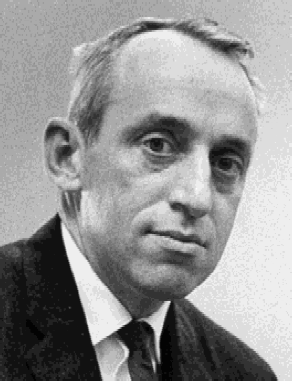James Tobin facts for kids
Quick facts for kids
James Tobin
|
|
|---|---|

Tobin in 1962
|
|
| Born | March 5, 1918 Champaign, Illinois, U.S.
|
| Died | March 11, 2002 (aged 84) New Haven, Connecticut, U.S.
|
| Institution | Yale University Cowles Commission |
| Field | Macroeconomics |
| School or tradition |
Neo-Keynesian economics |
| Alma mater | Harvard University |
| Doctoral advisor |
Joseph Schumpeter |
| Doctoral students |
William Brainard Willem Buiter Duncan K. Foley Koichi Hamada Edmund Phelps Janet Yellen Hiroshi Yoshikawa |
| Contributions | Portfolio theory Keynesian economics Tobin's q Tobit model Tobin Tax Mundell–Tobin effect |
| Awards | John Bates Clark Medal (1955) Nobel Prize in Economics (1981) |
| Information at IDEAS / RePEc | |
James Tobin (born March 5, 1918 – died March 11, 2002) was a famous American economist. He worked as an advisor for the US government and taught at Harvard University and Yale University.
Tobin helped develop ideas from Keynesian economics. This is a way of thinking that suggests governments should get involved to keep the economy stable. He believed this could help avoid times when the economy slows down, called recessions. His work also looked at how people invest money, how governments use spending and taxes (called fiscal policy), and how central banks control money (called monetary policy).
In 1981, James Tobin won the Nobel Prize in Economics. He received it for his "creative and extensive work" on understanding financial markets. This included how these markets connect to spending, jobs, production, and prices.
Outside of his university work, Tobin was well-known for suggesting a special tax on money exchanged between different countries. This is now called the "Tobin tax". He thought this tax could help reduce risky bets in the international currency market. He saw these bets as dangerous and not helpful for the economy.
Contents
Life and Career
Early Life and Education
James Tobin was born in Champaign, Illinois, on March 5, 1918. His father was a journalist, and his mother was a social worker. He went to a special school on the University of Illinois campus.
In 1935, Tobin took entrance exams for Harvard University and got in with a scholarship. While studying there, he read an important book by John Maynard Keynes called The General Theory of Employment, Interest and Money. Tobin graduated with top honors in 1939. His first published article, in 1941, was based on his senior paper about Keynes's ideas.
He started graduate studies at Harvard but paused to work for the government during World War II. He joined the United States Navy and served as an officer on a destroyer ship. After the war, he returned to Harvard and earned his Ph.D. in 1947.
Academic Work and Government Advice
In 1950, Tobin moved to Yale University, where he stayed for the rest of his career. He joined the Cowles Foundation, a research center, and led it for several years. His main research focused on understanding how individual choices affect the larger economy, especially in monetary economics.
Besides teaching and research, Tobin was also involved in public life. He wrote about economic issues and advised the government. From 1961 to 1962, he was a member of John F. Kennedy's Council of Economic Advisers. This is a group of experts who give advice to the US President about the economy. He helped create the economic plans used by the Kennedy administration. Tobin also advised the Federal Reserve System and the US Treasury Department.
Tobin received the John Bates Clark Medal in 1955. This award is given to an American economist under 40 who has made a significant contribution. In 1981, he won the Nobel Memorial Prize in Economics. He was also a member of important groups like the American Economic Association.
In 1972, Tobin and another Yale professor, William Nordhaus, wrote an article called Is Growth Obsolete?. This article introduced a new way to measure how well people are doing economically. It looked at how sustainable economic growth is for the future.
Tobin retired from Yale in 1988 but continued to give lectures and write. He passed away on March 11, 2002, in New Haven, Connecticut.
Personal Life
James Tobin married Elizabeth Fay Ringo on September 14, 1946. They had four children: Margaret, Louis, Hugh, and Roger. Elizabeth passed away in 2009 at the age of 90.
His Economic Ideas
James Tobin's ideas are still very important in economics today.
- The Tobin Tax: His idea for a tax on international money exchanges is still discussed. Some people believe it could help make global financial markets more stable.
- The Tobit Model: This is a math model he created to analyze data where some values are limited or "cut off." It's used a lot in economics research.
- Tobin's q: This idea helps explain why companies invest. It compares a company's market value to the cost of replacing its assets.
- Baumol–Tobin Model: This model helps explain how much money people choose to hold for everyday spending.
- Liquidity Preference: Tobin also explained how people decide to hold money instead of investing it. He showed that people are willing to take more risks with their investments if they expect a higher return. This idea simplified how economists think about investment choices.
See also
 In Spanish: James Tobin para niños
In Spanish: James Tobin para niños
- Basic income
- Guaranteed minimum income
- Q Ratio (Tobin's Q ratio)
- Tobit model (Tobin's model for censored endogenous variables)
- Tobin tax

